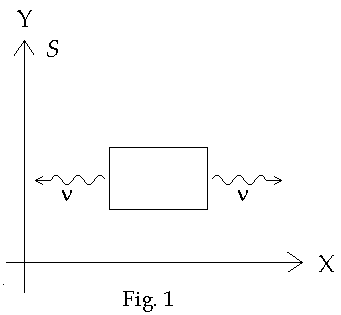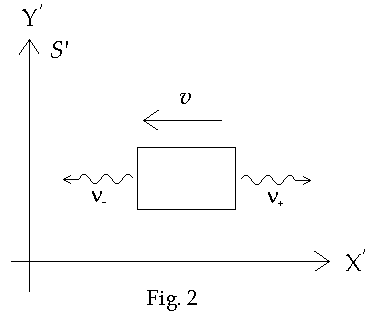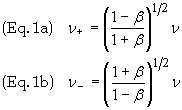

Mass
Energy Equivalence
Back
to Physics World
Back to Special Relativity
The
equation E = mc2
is probably the recognizable equation if all of physics and probably the one
which seems to me the most mystical as well. It is far from obvious what the
seemingly simple notion of energy discussed above has to do with mass at all,
beyond its relation with kinetic energy. The derivation here is in the spirit of
Einstein’s 1905 derivation, the same situation of body emitting radiation and
consideration of the scenario from two different inertial frames, the rest frame
of the body, S, and a frame moving relative to S.
Consider a body, at rest in the inertial frame S,
which emits two photons, each of frequency n,
one in the +x direction, the other in the –x direction. See the
figure below


The
total energy of the two photons is E = 2hn.
For energy to be conserved there must be a decrease in the energy of the body.
This implies that the body previously contained energy.
There must have been an internal change that resulted in a physical state
having lower value of energy. Since the total momentum of the photons is zero
the emitting body must remain at rest otherwise total the total momentum of the
system would not be conserved. The inertial frame S’ is in standard
configuration with respect to S and is moving in the +x direction
with speed v. In S’ the body is moving in the –x’ direction
with velocity v’ = -v ex.
An observer in S’ observed the body emit two photons. One photon is
emitted in the +x’ direction and the other in the –x’
direction. The photons have frequencies n+
and n-
respectively. The velocity of the body remains unchanged. Due to Doppler shift
the photon moving in the +x direction is red shifted from n
and the photon moving in the –x direction is blue shifted n.
The shifted frequencies, i.e. n+
and n-,
are related to n
by

The
total momentum in S’ before the photons are emitted is the initial
momentum of the body given by
![]()
where
m’i
is the initial mass of the body as measured in S’. If m’f
is the final mass of the body as measured in S’ then, since the
velocity of the body remains unchanged the momentum of the body after emission
is
![]()
The
momenta of the photons in S’ is given by
![]()
The
total energy of the photons as measured in S’ is
![]()
Conservation
of momentum requires that
![]()
Substituting
the values above gives
![]()
Upon
equating the components on each side we get, upon rearranging terms and
substituting the values in Eq. (19)

Eq.
(26) be simplified to
![]()
When
Eq. (19) is substituted into Eq. (23) we get

Substituting
the expression for E’ into the expression for the change in momentum in
Eq. (22)
![]()
We
arrive at our final result
![]()
Eq.
(3) states that if a body emits radiation having an energy E then there
is a decrease in the body’s inertial mass in the amount Dm
= E/c2.
This holds even when the body is at rest. Therefore the mass of a body is
related to its energy content in accordance with Eq. (33). A body rest has a
rest energy E0
= m0c2.